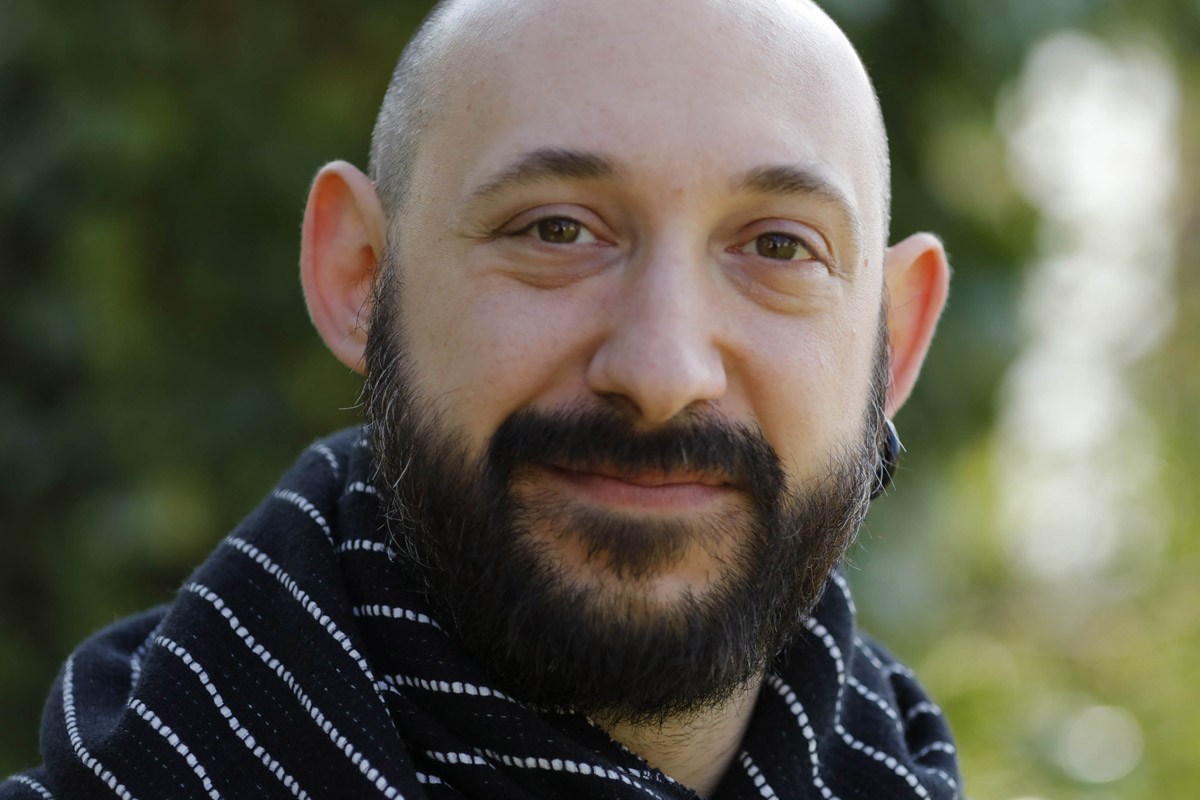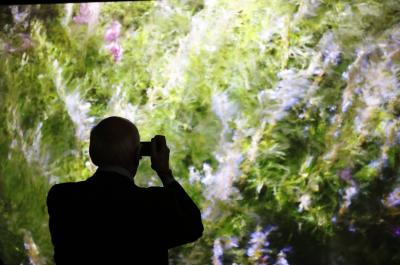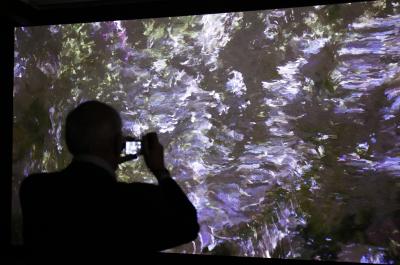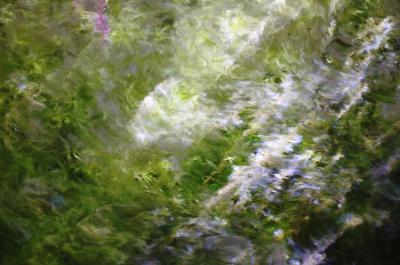I. Davide Quayola
“Jardins d'été”

In August 2016, Davide Quayola carried out a ten-day residency at Chaumont-sur-Loire during which he filmed and recorded the magic of the Historic Grounds’s and Goualoup Park’s dahlia, sage and delphinium beds. His residency resulted in a work entitled Jardins d’Été (Summer Gardens), which, thanks to the wonders of digital technology, immerses us in a fascinating “impressionist” world.
Jardins d’Été by Quayola pays homage to the tradition of french impressionism and the late works of Claude Monet.The second iteration of this series of artworks investigates the ways in which nature is observed, studied and synthesized, becoming a point of departure towards abstraction.
Quayola recreated similar conditions to the classical impressionist landscape paintings, however he engaged with an extensive technological apparatus to capture the sensitive nuances of reality beyond our senses. Here natural landscapes are observed and analysed through the eye of the machine, and re-purposed through new modes of visual synthesis.
Jardins d’Été consists of a series of 4K resolution digital video paintings inspired by the gardens of Château de Chaumont-sur-Loire. A wide range of floral compositions manipulated by high winds are filmed at night in ultra-high definition. Quayola edits the acquired videos with complex computational analysis of motion, composition and colour schemes which become the foundation for the creation of new algorithmic paintings.
JARDINS D’ÉTÉ (SUMMER GARDENS)
PHANTOMS FROM COLLECTIVE MEMORIES
"We usually assume that beauty is not a concern of contemporary artists. Not just that today’s artists don’t aim at achieving beauty, but that they have ceased to believe in beauty as an aesthetic category. For his previous works, Quayola has always chosen subjects that were representative of the Western canon of beauty and visually mesmerizing, but never as beautiful as the garden fragments of this new work. I write this not to provide a personal judgment, but to draw attention to this mysterious quality and to show its connection to our collective memory.
“Jardins d’Été” (Summer Gardens) is made of a series of videos of plants in full bloom, moved by a gentle wind. Over a few minutes, these plants emerge from an indistinct darkness to return to their natural form filmed in the original footage. The way they come back in sight, as if returning from intangible obscurity, evokes a dance movement: gradually, bouncing strokes of pinks, blues and greens scratch away the matter that kept them secluded. It is as if the plants themselves were demanding visibility, prompted by some natural instinct. This agency of plants is the best way to describe the type of beauty I have in mind.
What is the substance of this dark matter? We don’t know, but we feel that the flowers must have faded away until we lost sight of them, until their impression was firmly stored in our collective memory. In 2016, when the footage was filmed, it would be hard to think of a single artistic movement which has become more engrained into contemporary visual culture than Impressionism. Indeed, Quayola’s explicit inspiration for this work was Claude Monet’s last painting cycle, the Water lilies on permanent display in Paris since 1927. These monumental canvases combine everything essential in the space of the picture, including flowers, water, sunlight, ripples, refractions, and the depths of space. In this sense, the narrative of “Jardins d’Été” (Summer Gardens) essentially deconstructs Monet’s process that many have described as a tension towards abstraction. Historians of modern art described this tension as the amorphousness of Impressionism, and yet to say that Monet’s Water lilies have no form is to miss the point.
Quayola’s revival of Monet is a reminder that the forms of nature had not vanished – to be stored aside, in fact, is not the same as disappearing altogether.
The tension towards abstraction depends on the treatment of light. Generally, Monet is said to have worked mostly during the day in order to record the slightest variations of light on his subject. Hence, historians have discussed his paintings as series, like a film still is part of a sequence. Yet, the Water lilies installed at the Orangerie are not exactly a sequence, they are both capturing a moment and showing the different sections of a coherent place.
More importantly, the paintings have a dark basis and are framed by large black areas – with the exception of the first in the sequence, where bright yellows and oranges seem to reflect a sudden passage of sunshine. Monet’s palette of blues, greens, browns, and purples creates the impression of looking down on a water surface which simultaneously reflects the sky and reveals the depth of the pond. This is why it makes so much sense for Quayola’s gardens to have been filmed at night. Through this stratagem, they retain the colours of the summer feast, but they are filmed in the cold air of night, with the help of a giant torch that increases the effect of loss and retrieval, allowing us to see again. The dark substance of Quayola’s video ultimately suggests that the dark matter that forms the ground of Monet’s paintings is a metaphor of memory.
Once we see this metaphorical relation, we realise that for Monet, perhaps, his garden embodied the sense of nostalgia of a world he was struggling to translate into painting. The expression Monet used in his diary to describe his art was ‘saisir la nature’ (to seize nature), where the choice of verb betrays the artist’s concern with movement.
In the quest to capture nature itself, in fact, the movement inherent to nature becomes a challenge, the phenomenon that cannot be reproduced as such.
The means offered by the evolution of cinema and today’s computer vision have enabled Quayola to incorporate these movements in ways Monet could not have imagined. The only similarity between these immersive experiences lies in the fact that both admit two types of movements at the same time: that of nature, and that of our own bodies. Contrary to today’s immersive experiences which often they veer towards a total control environment and mimic the passive experience of cinema or television, both artists relinquishes from total control. Quayola’s work retains that vague quality that characterized Monet’s Water lilies, that freedom of movement that was sought in the design of the Orangerie. The architecture created by Monet with Camille Lefèvre is full of natural light, and the walls are painted white. Likewise, Quayola’s work is an invitation to slowly put things into focus through light and movement. It is a simple act of revelation, not of everything essential, but of what was there already.
But Quayola has had the possibility to hand over part of the work to the vision of the machine. And the inorganic sound that accompanies the videos as well as the absence of the particular fragrance of wet plants at night, increase the memory-effect but reminds us that only in nature can we experience everything essential. As in a dream, when perception occurs mainly in the form of visual stimulus, and vision becomes a doorway to the other senses which are just temporarily softened, so in Quayola’s videos the plants mobilise our memories. And yet, this does not mean that “Jardins d’Été” (Summer Gardens) is just about Impressionism, or about real flowers or plants. It does much more than that: it associates the flux of nature and film to the motions of memory." Camilla Pietrabissa
BIOGRAPHICAL NOTES
Davide QUAYOLA
ITALY

Regarded for his enigmatic video installations, Quayola creates hybrid spaces of animated painting and sculpture. Engaging a practice of audio-visual performance, drawing, photography and software programming, he explores a fine boundary located between the real and artificial.
Special institutional commissions of Quayola’s work have allowed him exceptionally rare access to the art and architecture of churches, theatres and museums in Europe, such as Notre Dame and the Vatican. In his work, original masterpieces and collections become raw canvas, as Quayola anchors a video-based exploration in a conversation about archives, collage, intellectual property and the appreciation of an object. In an age of the Google Art Project, which offers unprecedented access to the literal surface of a painting, Quayola handles the time we spend looking at art as a plastic artifact, something to be sculpted and suspended. The gaze is a place where the logic of a picture unfolds, seemingly excavated from beneath the image.
The first solo exhibitions of Quayola’s work opened at bitforms gallery in May 2012 in New York, and at Young Projects Gallery in March 2012 in Los Angeles. Past displays have included a 54th Venice Biennale project at the Italian Cultural Institute in London and exhibitions at the Victoria & Albert Museum, London; the British Film Institute, London; Gaîté Lyrique, Paris; Palais de Tokyo, Paris; Triennale, Milan; Park Ave Armory, New York; Palais des Beaux Arts, Lille; Museo Nacional d’Art de Catalunya, Barcelona; MoA, Seoul; UCCA, Beijing; Grand Theatre, Bordeaux; Church of Saint Eustache, Paris; Centro Cultural Recoleta, Buenos Aires; Museu da Imagem e do Som, São Paulo; as well as festivals such as Sonar, Barcelona; STRP, Eindoven; Cimatics, Brussels; onedotzero, London; Elekra, Montreal; and the Clermont Ferrand Film Festival, among others.
Also a frequent collaborator on musical projects, Quayola has worked with composers, orchestras and musicians including Ensemble Intercontemporain, Vanessa Wagner, Mira Calix, Plaid, Matthias Kispert and the National Orchestra of Bordeaux.
In 2005 he was awarded a BA from University of the Arts London.


